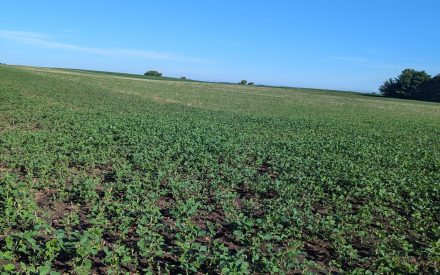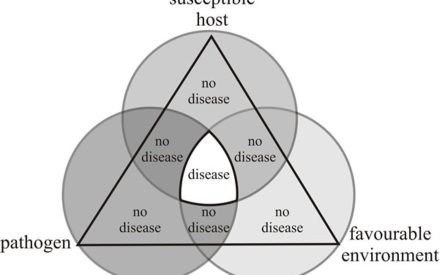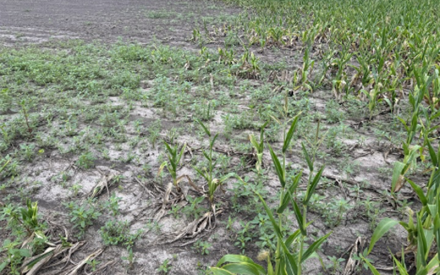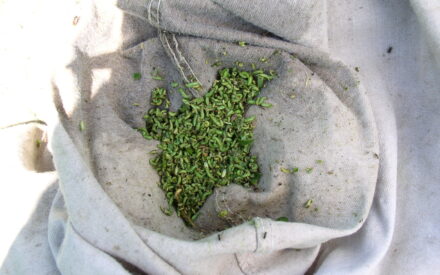While many Wisconsin farms use cereal rye exclusively as a cover crop, it can also be a valuable, high-quality forage for livestock. When planted after the harvest of common Wisconsin agronomic crops (e.g., soybean, corn, and wheat), it establishes quickly and provides great soil cover. Spring cereal rye harvest and management for forage production is an important consideration and more information can be found here: Planting winter rye after corn silage: managing for forage.
Additionally, if herbicides are used in the previous crop(s), the herbicide rotational interval stated on the label must be followed. A rotational interval is the required amount of time from herbicide application to subsequent crop establishment assuming the cover crop will be used for feed purposes.
For example, if an herbicide is applied to soybeans with a 10-month rotational interval for cereal rye, the rye can only be established as a feed crop 10 months after the herbicide application. While plantings that will only be used as a cover crop (prevent erosion, build soil health) do not need to follow the rotational interval, IF THE PLANT IS HARVESTED AND USED AS A FEED, THE USER IS REQUIRED BY LAW TO FOLLOW THE ROTATIONAL INTERVAL. The herbicide label lists the rotational interval and is recommended to be referenced prior to making any management decisions.
Designing an herbicide program to allow for cereal rye forage harvest
Designing an herbicide program that allows for control of your most troublesome weeds, while allowing for the use of cereal rye as feed, is challenging. Below we overview several steps that can assist you in developing a successful program.
What if you have cereal rye that could be harvested for forage today?
Review the herbicide labels applied for the past 24 months for rotational restrictions that would prohibit the harvest of the cereal rye for forage. If there are no rotational restrictions for the harvest of cereal rye for forage, proceed with planning for forage harvest.
Terminating cereal rye
Terminate the cereal rye after cereal rye harvest. Glyphosate is the most common active ingredient used for cereal rye termination. University studies have shown glyphosate will translocate and terminate the rye, even if minimal plant material is on the soil surface. Termination applications need to occur when the rye is actively growing to allow for herbicide translocation. Reduced rates have shown inconsistent control and are not recommended.
Work through the above steps one through four and continue to use your most troublesome and challenging weeds to guide your herbicide options. Consider herbicide tolerant crop traits when making future seed purchases that complement the cropping system. Reference the below University of Wisconsin-Madison publications to help guide herbicide selection, cereal rye harvest, and termination. Always read, understand, and follow the pesticide labels used in the crop rotation and track the herbicide rotational intervals over several seasons to ensure legal forage harvests are possible.
Resources
DeWerff R., E.N. Bick, P. Liesch, M. Renz, D. Smith, R. Werle, J. Kampa. 2025. Pest Management in Wisconsin Field Crops. University of Wisconsin-Madison Extension Publication A3646.
Paris, N., D.H. Smith, R. Werle, T. Severo Silva, R. DeWerff. 2024. Herbicide Rotational Restrictions for Cover and Forage Cropping Systems.
Smith, D.H, M. Broeske, J. Patton, K. Shelley, F. Arriaga, B. Jenson, M. Coura Oliveira, B. Briski, B. Bubolz, R. Rushmann, H. Johnson, G. Schriefer, M. Sorge. 2019. Cover Crops 101. University of Wisconsin-Madison Extension Publication A4176.
Stute, J., K. Shelley, D. Mueller, T. Wood. 2007 Planting winter rye after corn silage: managing for forage. University of Wisconsin Nutrient and Pest Management Program Publication.

 ▶ 2025 Corn and Soybean Weed Management: Field Observations and Research Updates
▶ 2025 Corn and Soybean Weed Management: Field Observations and Research Updates ▶ Introduction to Common Crop Diseases
▶ Introduction to Common Crop Diseases ▶ Basic Weed Identification for Crop Scouts
▶ Basic Weed Identification for Crop Scouts ▶ Basic Insect Identification for Crop Scouts
▶ Basic Insect Identification for Crop Scouts


